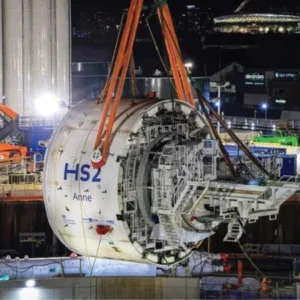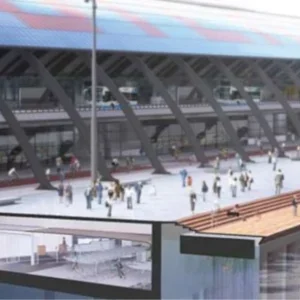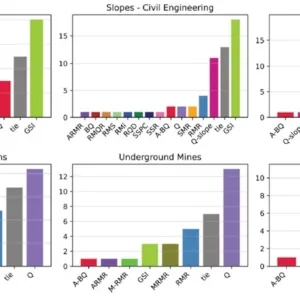Every time a tunnel at shallow depth has to be built in the presence of ground water, the problem of dewatering needs to be addressed. A typical solution is to shield the excavations with preliminary or auxiliary wall structures. In practice this could lead to the application of cut and cover construction or its inverse derivative, the top down method.
Although the side walls and lid of such underground structures can usually be built rather easily from the surface, watertightness of the excavation is only achieved if the side walls reach impermeable ground at the bottom. Impermeability at the bottom of the excavation can also be achieved by measures such as grouting or constructing concrete floor slabs.
However, in a number of cases, the usual approaches may not be feasible. Adverse geological or hydrological conditions can place considerable obstacles or even unsolvable problems in the way of constructing a watertight excavation base. This applies, for instance, where impermeable ground layers are not encountered within a reasonable depth or where stratigraphic sequences include karst or fissured rock.
Further difficulties can arise where enhanced environmental demands prevail, especially if the groundwater serves as a reservoir for potable water. Under such circumstances it is favourable to exclude the water at the excavation base without driving further solid structures or artificial materials into the ground.
In such cases, compressed air could be considered as a reliable method of achieving a dry base. The compressed air method used is similar to that applied in the use of diving bells, and is subject to the same physical laws. Hence the following governing rules need to be applied:
Putting these preconditions into practice typically results in the following construction sequence:
i) Construction of diaphragm walls along the longitudinal sides of the future tunnel, to a certain depth below the final bottom slab of the future structure.
ii) Construction of the lid for the tunnel. This phase may be supported by preliminary water drainage measures, if circumstances require and permit. The design of the lid, the diaphragm walls and the joints between these elements need to focus on the utmost impermeability of compressed air.
iii) Construction of a bulkhead with locks for men and materials/muck at one portal of the future tunnel. To prevent air from escaping longitudinally towards the other end of the tunnel, complementary temporary diaphragm walls may be inserted at regular distances along the tunnel axis and definitely at the far end portal.
iv) Commissioning of mechanical and electrical equipment for the supply of pressurised air, of equipment for muck removal and of supporting plant.
v) Application of compressed air and excavation of the tunnel cavity underneath the lid, starting at the portal, with linear progression towards the far end. The bottom slab and the inner lining may be completed a few meters behind, yielding the shell for the final structure.
However logical this construction process might seem, any practical application of the technique will reveal numerous detailed problems. Above all health and safety matters require the utmost attention when men are exposed to compressed air. To avoid the horrifying medical phenomenon of decompression illness, barotrauma, the daily hours for an individual working in compressed air are limited and sufficiently long decompression cycles in the man lock have to be allowed for.
In Germany, and in some other countries, the concerning parameters and concepts (timelines, levels of air pressure, application of oxygen, rescue services and installations, medical prevention, training of workforce, “less one can do” principle, etc.) are prescribed by statutory regulations and codes, derived from scientific findings. The impact on planning, site operations and expenditures resulting from these important precautions must not be underestimated.
Furthermore, any kind of combustion has to be strictly avoided in an environment of elevated air pressure. Not only does this fact totally exclude combustion engines, common welding equipment and cigarettes from service in compressed air, it is also a major safety concern.
The Audi Tunnel at Ingolstadt
A tunnel recently completed using this method was built for the future European high-speed railway line between Scandinavia and Italy. Where this line passes through the city of Ingolstadt, in Bavaria, Germany, the major civil and railway engineering contract was awarded to a consortium lead by former Dyckerhoff & Widmann, (now operating under the name of Walter-Bau), in joint venture with Ed Züblin. Structures designed and built by the consortium include a tunnel under the grounds of the well-known Audi car factories, a bridge over the river Danube and numerous other structures in the course of the inner city railway line. The tunnel section has a length of some 1250m and a cross section area of about 110m². The alignment, the gauge and the permanent installations of the turnkey project are designed for twin railway tracks with trains running at speeds up to 300km per hour.
Geological and hydrogeological conditions in the area merited extensive scientific studies (see bibliography). The area is determined by (qks) a sequence of sandy silty gravel and (tt) micaceous fine sand over silts and clays, followed by (tk) cretaceous clay containing beds of rearranged Jurassic gravel, limestone and dolomite. These are followed by (ti) karstified Tithonian limestones and dolomites.
It was important to realise, when choosing the most appropriate construction method for the tunnel, that two individual ground water tables would be encountered, separated by layers of relative impermeability. Due to artesian conditions, the porewater pressure on the lower levels is equal to a hydrostatic level of some 2m above the ground surface.
To cope with the artesian water pressure, the client (the German railways Deutsche Bahn) proposed a cut and cover method with a dam on either side of the trench. Inevitably, certain works would have had to be carried out under water, such as sub-aqueous anchors at the side walls and the bottom slab. The latter were regarded by the authorities as an environmentally critical intrusion on ground water resources of the entire region.
During the tender phase the pre-bid joint venture developed an alternative solution for the tunnel, taking advantage of the principles of compressed air, and submitted an alternative tender. Considering the lower price, as well as numerous technical and organisational advantages, the client awarded the contract to this consortium, and its proposal of a top down method with compressed air was put into practice.
Various engineering solutions had to be developed in addition to the pure principles for this construction method. To prevent the shell structure from hydraulic uplift, temporary ballast had to be placed on the lid until the bottom slab had been completed. Production joints between concrete sections were avoided wherever possible to minimise the dissipation of compressed air. For the same reason the structure, composed of diaphragm walls and lid, was designed as a rigid frame to enhance crack control for the longitudinal joints. As an effect of this design concept, the overall amount of reinforcement could be reduced.
Particular attention was given to potential problems with water pressure, especially at the invert near the face as excavations progressed. As geological conditions in reality differ from the theoretical model, pressure relief drainage wells were introduced during the course of the excavations. This turned out to be necessary for the balance of water pressure and air pressure in areas of tertiary sand layers.
Throughout the entire excavation phase the geological and hydrological conditions encountered were continuously recorded and evaluated on site by a geologist. The higher artesian Tithonian ground water was balanced by overburden in combination with compressed air.
The tunnel and the entire project are now complete. With hindsight the following further observations may be recorded as typical properties of the method:
However, it should be stressed, the above statements must be discussed relative to the differing circumstances of any particular project.
Conclusions
The Audi Tunnel project at Ingolstadt demonstrates an exemplary application of the use of compressed air in modern civil engineering. In this case, the top down construction method with compressed air has not only been more economic than any other alternative, but has also contributed to the viability of the underground works in this particularly sensitive location.
The method may well be regarded as a rather straightforward application of fundamental civil engineering skills. Nevertheless it requires a detailed investigation into the boundary conditions of different projects and the adaptation of the technology to suit each variance.
As with any advanced technology, this may provoke considerable demand for expertise and for highest professional standards. Additionally, such elite technical undertakings can only evolve in the presence of sound managerial and entrepreneurial competence.
Related Files
Fig 1 – Longitudinal section of the Audi Tunnel
Fig 2 – Top down construction method with compressed air
Fig 3 – Synopsis of preparations for compressed air on the Audi Tunnel
Fig 4 – Dissipation of compressed air during the construction of the Audi Tunnel, as observed






